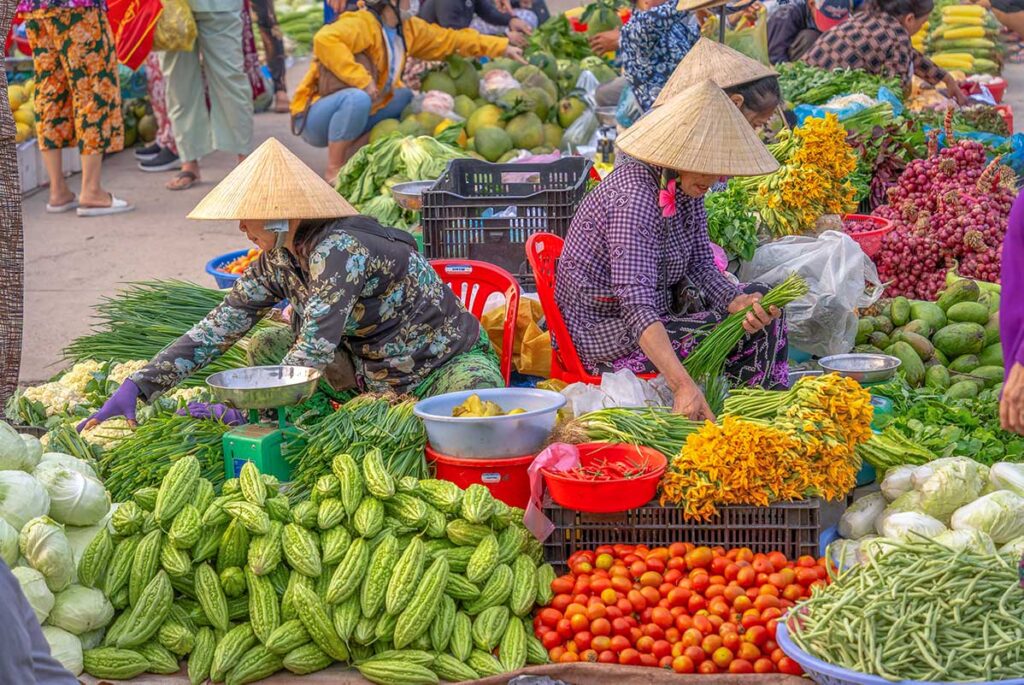What is Vi Thanh Market (Cho Hom)?
Vi Thanh Market is a traditional outdoor market in the city of Vi Thanh, Hau Giang Province, right in the heart of the Mekong Delta. Locals often call it a “Cho Hom” or squat-down market because vendors don’t use permanent stalls. Instead, they simply squat or sit on small stools, laying out their goods in neat 2–4 m² spaces marked on the ground. From above, this grid of sellers and produce looks surprisingly orderly, which has made the market well known among photographers.
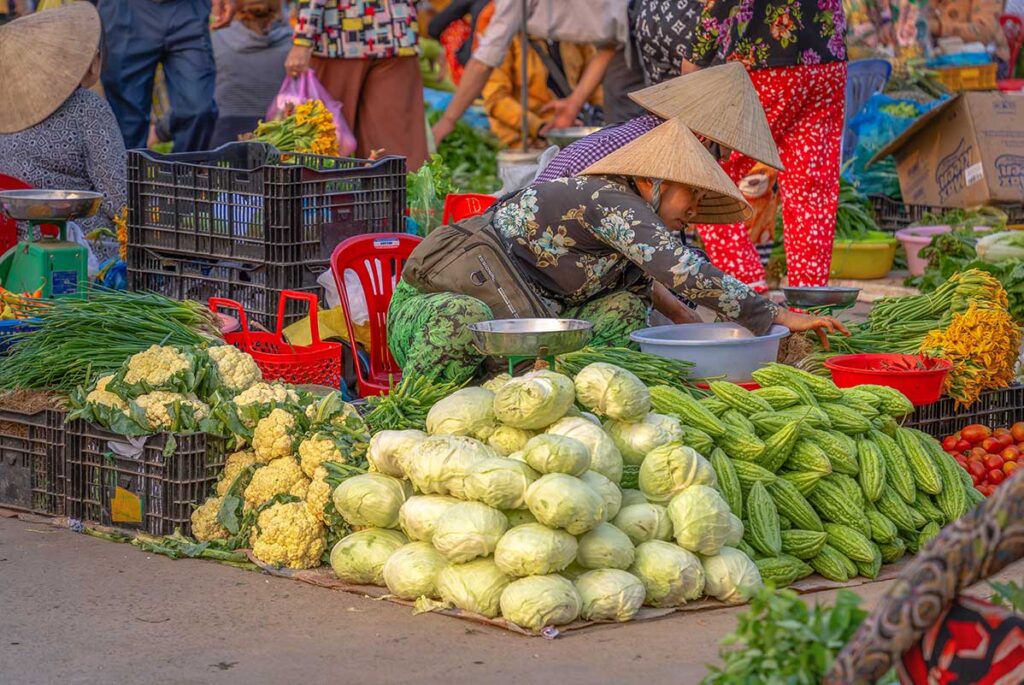
It’s sometimes described as the most beautiful squat-down market in Vietnam, not because of fancy architecture but because of its rustic simplicity and tidy arrangement. What makes it stand out is that most of the sellers are farmers themselves. They bring vegetables from their gardens, fish or shrimp from nearby rivers, and even homemade snacks directly to the market. Prices are usually lower than in city supermarkets or bigger markets, and the atmosphere feels more like a rural gathering than a commercial center.
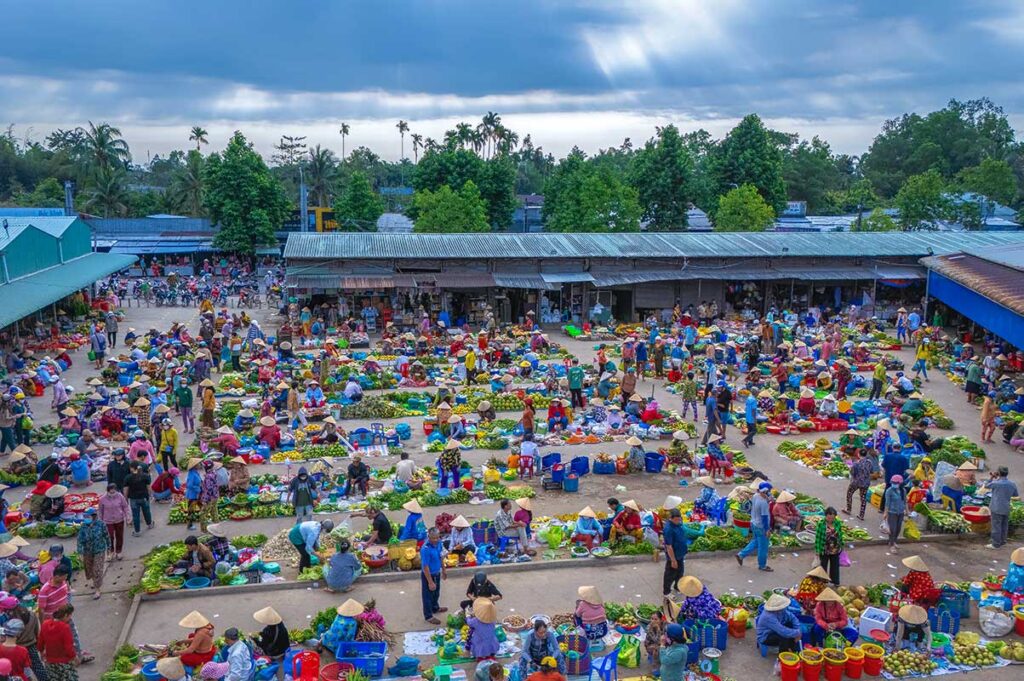
For visitors, this means you’ll see a slice of genuine Mekong Delta life right inside a provincial capital. It’s not a tourist market with souvenirs or staged activities—it’s a working market where local people shop for their daily meals. That contrast—an authentic countryside scene tucked into an urban setting—is what makes Vi Thanh Market worth noticing.
Highlights when visiting Vi Thanh Market
1. Rustic Cho Hom Layout

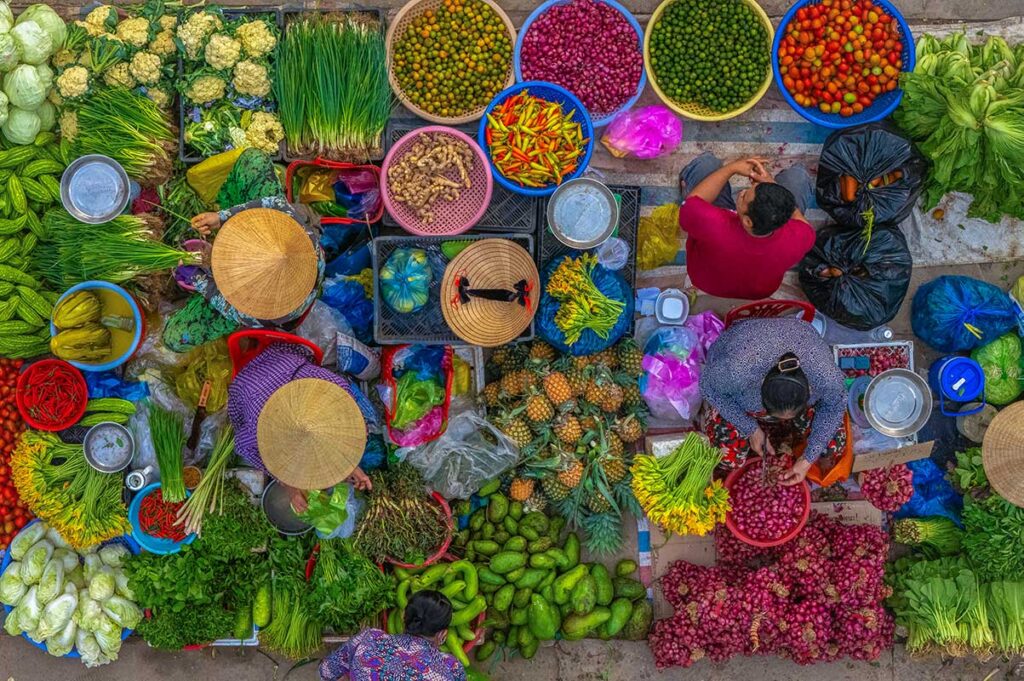
The market is best known for its simple setup: vendors squat on the ground or perch on small plastic stools, with their goods arranged neatly within marked 2–4 m² squares. This unusual grid system makes the market look tidy compared to many other rural markets in Vietnam. From above, the symmetry of baskets filled with greens, fruits, and fish creates a striking patchwork of colors—one reason the market has become a favorite subject for drone photographers.
2. Fresh Produce & Rural Specialties
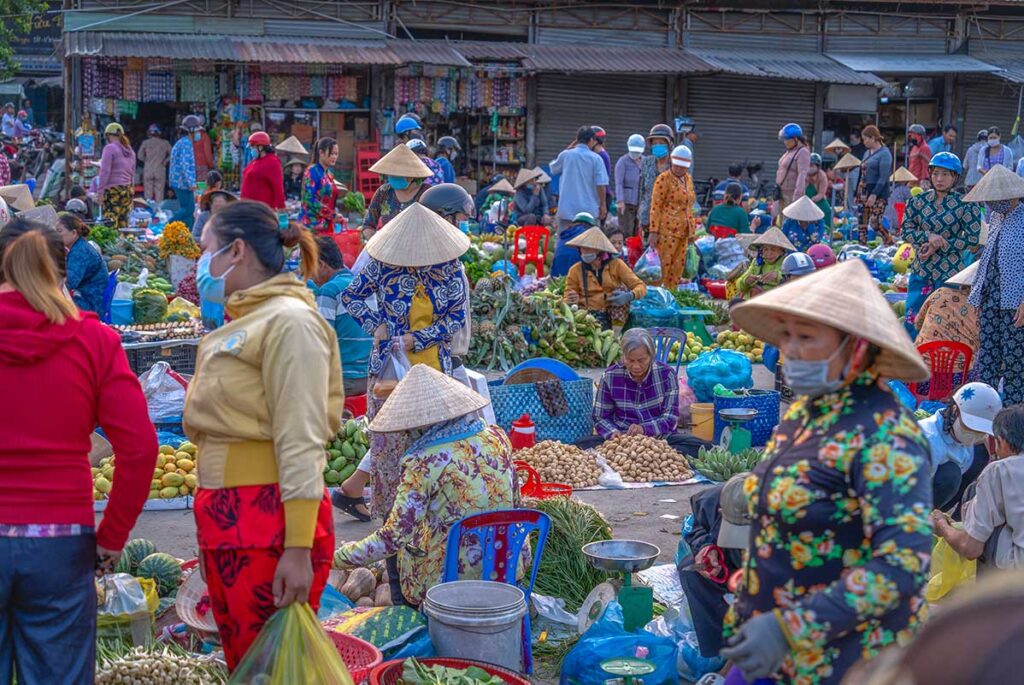
Vi Thanh Market is first and foremost a place for locals to shop for their daily meals. You’ll find a huge variety of fresh produce, from herbs and leafy vegetables to tropical fruits like mango, jackfruit, and bananas. On the protein side, there’s fish, shrimp, and eels caught in nearby rivers and ponds. For the more adventurous, you may also see frogs, field rats, and snakes—foods that are part of the traditional Mekong Delta diet but may surprise foreign visitors. Because the vendors are usually the farmers themselves, prices are low and freshness is guaranteed.
3. Traditional Snacks & Local Flavors
Besides fresh ingredients, the market is also a good spot to try local bites. Women prepare and sell homemade sticky rice, bánh bò (fermented rice cake), banana cake, and sweet soups. There’s also a small food court area where you can sit down for a bowl of noodles—bun rieu (crab noodle soup) and duck noodle dishes are among the specialties mentioned by travelers. Expect very local flavors at very local prices.
4. Atmosphere & Photography
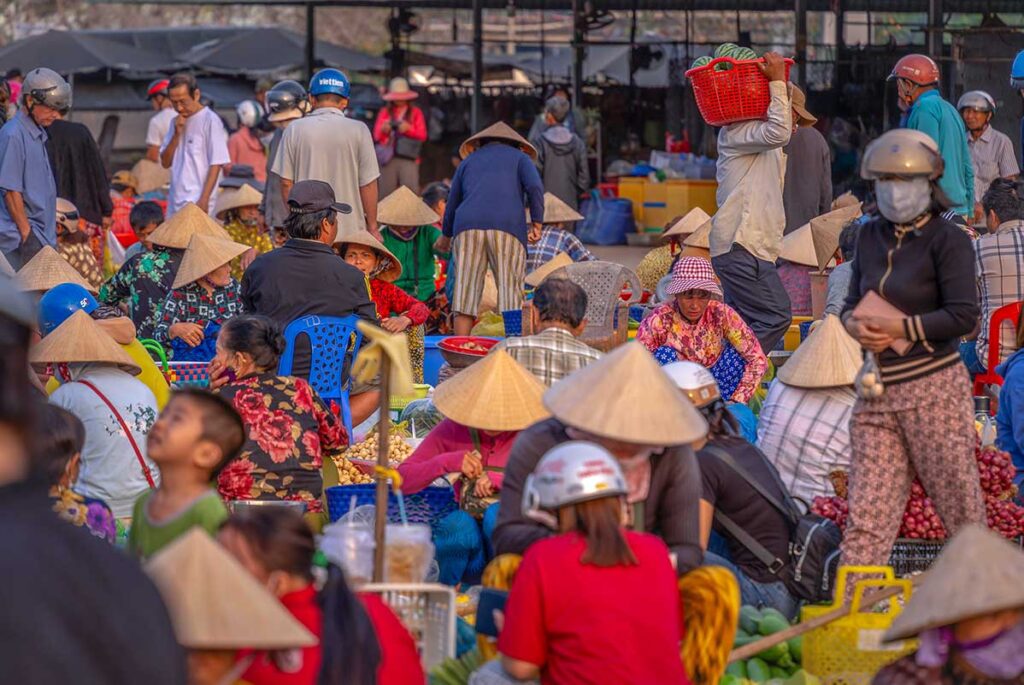
The market is at its liveliest in the early morning, especially between 6 and 8 AM. By 10 AM, things quiet down as vendors pack up. For photographers, this is the golden window: the light is soft, the market is crowded, and the visuals are at their best. Drone shots capture the orderly layout beautifully, but even without one, the scene is colorful and authentic. If you want to take close-up portraits, it’s best to ask first—most vendors are friendly and happy to smile for a photo if approached politely.
Location and How to get there
Where is Vi Thanh Market?
Vi Thanh Market is located in the center of Vi Thanh City, the capital of Hau Giang Province in the southern Mekong Delta. The market sits near Cai Nhúc Bridge on Trần Hưng Đạo Street, right beside the river and the main road. Despite being in the middle of a provincial city, Hau Giang itself is not on the typical tourist route, so you won’t find crowds of foreign visitors here. This is part of what makes the market feel authentic and “off the beaten track.”
How to visit
The closest major hub is Can Tho, about 1–1.5 hours by road (roughly 48 km). From there, you have several options to reach the market:
- Private car with driver – The most convenient and comfortable option. You can leave very early to catch the market at its peak, and combine the visit with other stops in Hau Giang or nearby provinces.
- Tour with local guide – If you want more context and to explore the countryside, this is the best way. Guides can include the market as part of a broader day trip.
- Motorbike rental – The ride from Can Tho is straightforward, with a decent road and relatively light traffic compared to other parts of Vietnam. However, you’ll need experience and a valid license to be covered by insurance. Riding in the dark (before sunrise) requires extra caution.
When you arrive, parking is hassle-free. You can leave your bike or car by the river or in the square near the market, usually without charge.
Practical visiting information & Tips
Opening hours & Best time
The market opens very early, from around 2 AM until 10–11 AM. The busiest period is between 6 and 8 AM, when locals come to buy fresh ingredients for the day. If you want to see the market in full swing, plan to arrive during these hours. For travel and photography in general, the dry season (December–April) is the most comfortable time to visit.
Entrance fee
There is no entrance fee for visitors. Vendors, however, rent small marked spaces for about 20,000 VND per session, which is part of why the market looks so neat and organized compared to many other rural markets.
Food & Snacks
Besides produce, the market is also a place to eat. You’ll find simple noodle soups like bun rieu (crab noodle soup) or duck noodles, often served from tiny food stalls near the river. For something sweet, try sticky rice, bánh bò, banana cake, or local sweet soups. The food is tasty, very local, and extremely affordable.
Photography Tips
The early morning light is best for capturing the vibrant colors of the market. If you have a drone, the aerial view highlights the unusual grid layout beautifully—just keep a respectful distance and avoid flying too low. For close-up shots, a smile and a polite ask go a long way. Most vendors are open to being photographed, but showing respect is key.
What to Expect
Vi Thanh Market is an authentic local market, not set up for tourists. English is rarely spoken, and there are no souvenir stalls or staged performances. A typical visit takes about 30–60 minutes, making it a quick but memorable stop rather than a full-day activity.
Other places & Sights to combine with
Visiting Vi Thanh Market doesn’t take long—usually less than an hour—so it’s best to make it part of a wider day trip or multi-day journey through the southern Mekong Delta. Hau Giang and the neighboring provinces offer plenty of cultural and natural stops that complement the market experience.
Countryside exploration
The real charm of Hau Giang lies in its countryside. Once you leave the town, you’ll find rice fields stretching to the horizon, quiet canals shaded by coconut palms, and fruit orchards where farmers tend their gardens. Driving or cycling through these backroads gives you the kind of rural Mekong Delta scenery that most travelers miss.
Local temples & Culture
For those interested in local culture, there are a few notable religious sites in Hau Giang:
- Bo Tum Vong Say Khmer Pagoda – A Khmer-style temple with colorful architecture that reflects the province’s Khmer community.
- Truc Lam Zen Monastery – A peaceful Buddhist complex located just outside Vi Thanh, good for a short cultural stop.
Nearby provinces
If you’re planning a broader trip, Vi Thanh is a convenient stop before continuing deeper into the Mekong Delta:
- Soc Trang – Famous for its many Khmer temples and the smaller but authentic floating market.
- Bac Lieu – Known for the Prince’s House, vast salt fields, and the Bac Lieu Bird Sanctuary.
- Ca Mau – The southern tip of Vietnam, where you can visit Cape Ca Mau National Park.
- Rach Gia – A practical hub if you want to take a ferry to Phu Quoc Island or the lesser-known Nam Du Islands.
